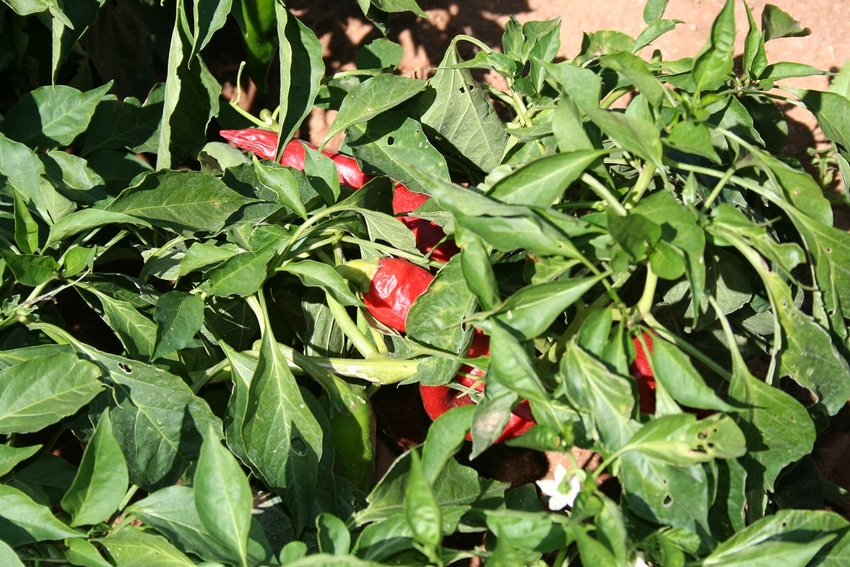
A new mechanical green chile harvester and a new chile de-stemming machine, both the handiwork of Israeli inventors Elad Etgar and Nag Kodali, wrapped up the first in a series of field trials on a chile farm near Hatch, New Mexico. Results were mixed but promising according to project organizers.
The idea behind development of the new machines came after chile farmers across the state and officials involved with the New Mexico chile industry sought a mechanical answer to the problems of finding enough farm labor to harvest the crop and ways to reduce production costs to remain competitive in a global marketplace.
Investors, inventors and interested industry experts including farmers, state and Extension officials gathered at a chile farm owned by grower Scott Adams to watch the harvester pass through chile fields and deliver crates of fresh-picked chile to the de-stemming machine.
Project investor Haim Oz, President and CEO of Oz Agribusiness Projects & Investments and a primary investor involved in the mechanized systems, says this two-week test period is the first of many he expects before the new system is perfected and ready for wide-spread use.
For the latest on southwest agriculture, please check out Southwest Farm Press Daily and receive the latest news right to your inbox.
Field testing is crucial
"When you get the opportunity to test new machines like these in the field, you learn a great deal that can help you make adjustments to make them work even better; up to expectations," he said.
Oz and inventors Etgar and Kodali hope once the machines are ready for mass marketing, New Mexico chile growers will be able to cut production costs as much as 50 percent. Farmers estimate current costs to produce and harvest the chile run between $2,500 and $3,000 an acre, so a reduction in costs anywhere close to 50 percent would be a major boost to an industry that has been declining in recent years.
In the early 1990s, the New Mexico chile industry acreage peaked at just over 35,000 acres. In recent years acreage has fallen to less than 10,000 acres.
Reasons for acreage decline
The reasons for the decline are many. A multiple-year drought since 2010 has forced growers to depend on limited ground wells for irrigation. But the onset of foreign competition in recent years has been of greater concern. Lower labor costs in farms in both Mexico and parts of South America have left New Mexico chile growers at the top of the wholesale/retail price list.
To help counter that trend, the New Mexico chile industry, with the help of the New Mexico legislature, adopted strict laws that prohibit chiles grown outside state borders to be labeled as 'made in New Mexico.’ Industry experts, like New Mexico Chile Association's Jay Hawkins, says green chile grown outside of New Mexico fails to meet the standards of quality and taste.
She says the secret to the flavor of New Mexico-grown chile is the combination of soil and climate, a position shared by most chile consumers in New Mexico and adjoining states.
According to a New Mexico Chile Association poll, 80 percent of consumers who typically purchase chile say it is important that the chile is grown in New Mexico, and 77 percent say chile grown within the state tastes better than any other variety of chile grown elsewhere.
While the new state law has helped to promote the New Mexico chile within state borders, and despite the good reputation and acceptance of New Mexico chiles spreading to more consumers nationwide and globally, the production cost difference remains a contributing factor to the industry's downward slide in recent years.
Effect on hand labor
But in spite of the industry's decline, and in spite of hopes that mechanization can help to save the industry in the years ahead, there are some within the industry that do not agree.
A loosely organized group of chile pickers weighed in on the subject last week and expressed their doubts and concerns over mechanization of the industry. Jesus Soto, who has been hand picking chile most of his adult life, says careful selection of the chile is required to ensure which chiles are ripe for harvest and which need to remain on the plant for ripening. He argues that mechanical pickers can not make that decision.
Yet there were interested growers present at the trials last week who say they see no future unless the industry can be mechanized.
Inventors and investors in the new machines tested this season say they are still a few years away from perfecting mechanization of New Mexico's chile harvest and plan to be back next year with improvements they have already discovered are needed. They say early testing, while not perfect, has shown cause to be optimistic that the machines can be improved to a point that the process will not only be efficient, but cost cutting.
About the Author(s)
You May Also Like




